Scottish Health Survey – telephone survey – August/September 2020: main report
Presents results for the Scottish Health Survey – telephone survey- August to September 2020, providing information on the health and factors relating to health of people living in Scotland.
This document is part of a collection
Chapter 6: Alcohol
This summary covers data collected between the 5th August 2020 and the 23rd September 2020.
The proportion of adults* who consumed alcohol on more than 5 days in the week prior to being interviewed increased with age.
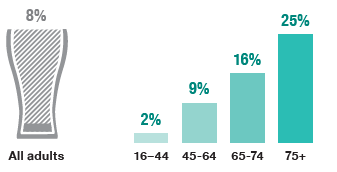
A similar pattern was also evident for the mean number of days on which alcohol was consumed over the past week*.
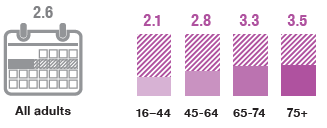
The proportion of men* who drank more than 8 units on their heaviest drinking day was higher than the proportion of women* who drank more than 6 units.
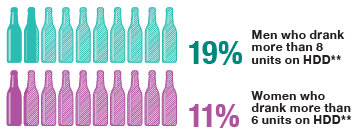
Men were also more likely to have consumed a higher mean number of units per week on their HDD** than women across all age groups*.
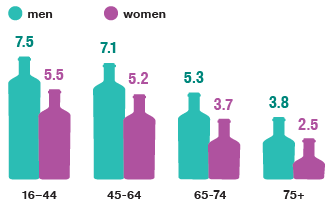
Significant proportions of people reported changes to their drinking habits between the start of lockdown*** and the date of the interview.
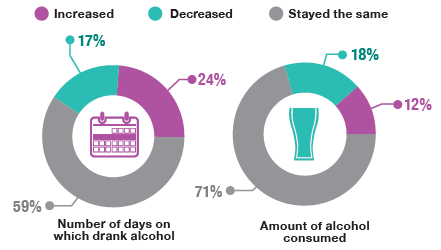
Younger adults† were more likely to report an increase in the frequency and quantity of alcohol consumed since the beginning of lockdown***.
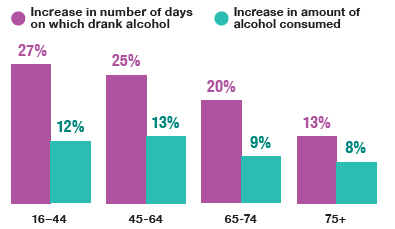
Adults† who had been advised to shield were less likely to report an increase in the number of days on which they drank alcohol since the beginning of lockdown***.
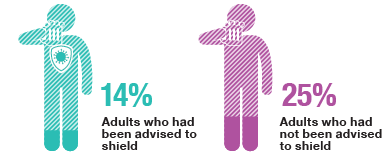
* Among those who had consumed any alcohol in the past week.
** Heaviest drinking day.
*** Lockdown began on the 23rd March 2020. †Adults who consumed alcohol at all nowadays.
6 Alcohol
Alex Scholes
6.1 Introduction
Harmful alcohol consumption is recognised as a major, long-lasting public health challenge in Scotland, carrying with it a risk of physical and mental health problems, as well as social and economic losses to individuals and society[1]. In 2019, 9.9 litres of pure alcohol were sold per adult in Scotland (same as in 2018), equivalent to 19.1 units per adult per week, representing enough alcohol for every adult to substantially (by 36%) exceed the low risk weekly drinking guideline (14 units), despite being the lowest level seen since 1994[2]. The UK Chief Medical Officers (CMOs) published revised guidelines on alcohol consumption in January 2016, advising both men and women that it is safest not to regularly consume more than 14 units of alcohol per week, to spread the amount drunk over a number of days and to limit consumption in a single session[3].
In the financial year 2019 to 2020, alcohol-related problems resulted in 35,781 stays in general acute hospitals[4] and in 2019, there were 1,020 alcohol-specific deaths[5]. Existing inequalities mean that the burden of alcohol-related morbidity and mortality is greatest among those living in the most deprived areas[6,7].
The Alcohol Framework 2018: Preventing Harm[8] endorses the WHO Safer initiative of evidence-based strategies to tackle alcohol-related harm[9] and includes actions related to putting the voices of children and young people at the heart of alcohol preventative measure development; reducing alcohol consumption through affordability; supporting families and communities, keeping the licensing system and statutory guidance under review and consulting on marketing restrictions.
It is not yet clear what the wider impact of the COVID-19 pandemic will have been on alcohol sales and harm at a population and sub-group level. The Scottish Government is working with Public Health Scotland to better understand this and a report will be published in due course. Evidence to date is suggestive of varying impacts of the pandemic on alcohol consumption[10,11]. On-trade licensed premises were closed during the initial lockdown period, however, purchasing alcohol from some parts of the off-trade, such as supermarkets was still possible. Since 15th July 2020 and throughout the period of data collection, lockdown restrictions were eased and indoor hospitality could open (subject to physical distancing rules and guidance) however, as virus cases increased, variable restrictions were put in place again[12].
This chapter reports on the number of days in the previous week on which adults drank alcohol, and the mean number of units on the day they drank the most, as well as any self-reported changes to the amount they consumed since lockdown began. Information on methods and definitions can be found in Volume 2: Technical Report.
6.2 Alcohol
The fieldwork period referenced in the following analysis covers from the 5th August 2020 to the 23rd September 2020.
In interpreting these results, note that, in this survey these questions were asked as part of the main interview. However, in the usual format of the Scottish Health Survey, younger adults aged 16-17 are only asked about alcohol consumption as part of the self-completion questionnaire rather than the interviewer asking the questions and younger adults aged 18-19 are offered the opportunity to complete these questions as part of the self-completion questionnaire rather than as part of the main interview. The self-completion format enables younger adults, particularly those living within the family home, to answer these questions privately should they wish to do so.
In addition, patterns of drinking behaviour tend to vary by deprivation and as response to this survey was lower than usual in deprived areas this may have impacted upon the estimates presented here. See section 1.9.7 of the technical report for more on the alcohol measures used in the survey.
6.2.1 Number of days on which adult drinkers drank alcohol in the past week, August/September 2020, by age and sex
Just under one in ten adults reported that they had drunk alcohol on more than five days in the week prior to being interviewed (8%) with no significant difference by sex. Significant differences were evident by age with proportions increasing from 2% of those aged 16-44 to 25% of those aged 75 and over. Similar patterns by age were observed for men and women.
On average, adult drinkers drank alcohol on 2.6 days in the past week; with the figure for men (2.7) being slightly higher than for women (2.5). There was a positive correlation between the mean number of days on which alcohol had been consumed in the past week and age, rising from 2.1 days among adults aged 16-44 to 3.5 among those aged 75 and over.
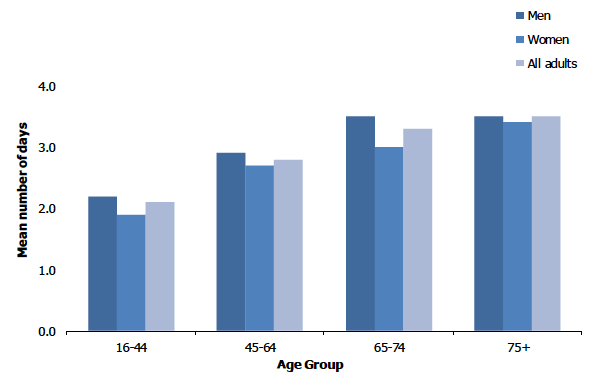
Figure 6A, Table 6.1
6.2.2 Estimated units consumed on heaviest drinking day, August/September 2020, by age and sex
During the fieldwork period, the proportion of men who drank more than four units on their heaviest drinking day (37%) was higher than the proportion of women who drank more than three units on their heaviest drinking day (30%). The proportion of adults that reported having consumed three or four units on their heaviest drinking day decreased from 34% - 39% of adults aged 64 and under to 15% among those aged 75 and over.
The proportion of men drinking more than eight units on their heaviest drinking day was higher than the proportion of women drinking more than six units on their heaviest drinking day (19% compared with 11% respectively). Variations in prevalence by age were evident in the proportion of adults estimating having drunk over six or eight units on their heaviest drinking day, with the lowest proportion reported among those aged 75 and over (3%) and the highest among those aged 16-64 (17% - 18%).
Among adult drinkers, the mean number of units consumed on their heaviest drinking day was 5.9 with male drinkers consuming, on average, more units than female drinkers (6.7 compared to 4.9). The mean number of units consumed by drinkers on their heaviest drinking day decreased with age from 6.6 among those aged 16-44 to 3.2 among those aged 75 and over. Similar patterns were found for men and women.
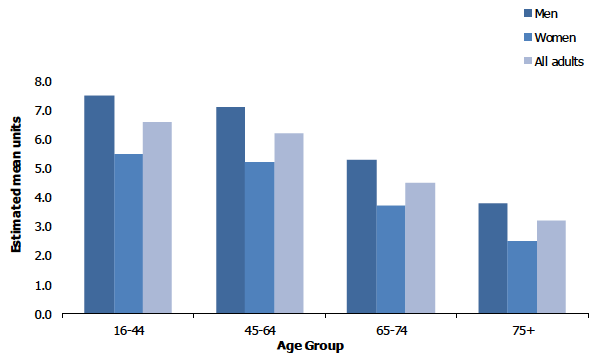
Figure 6B, Table 6.2
6.2.3 Self-reported changes to frequency or amount of alcohol consumed since lockdown began (23rd March), August/September 2020, by age and sex
The majority of adults reported that the number of days on which they drank alcohol and/or the amount of alcohol they consumed on a typical day had stayed the same (59% and 71% respectively) between the 23rd March 2020 and the fieldwork period.
While 24% of adults reported that the number of days on which they drank alcohol per week had increased between the start of lockdown and the fieldwork period, 17% reported it had decreased with no significant differences by sex.
Younger adults were more likely to report an increase in the number of days on which they drank alcohol since lockdown began (proportions decreased from 27% among those aged 16-44 to 13% among those aged 75 and over). Similar patterns by age were found for men and women.
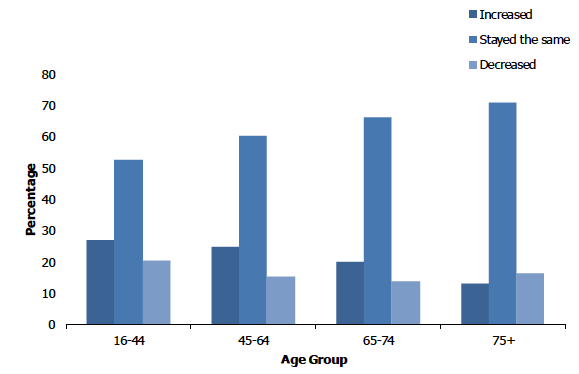
Just over one in ten adults (12%) reported that the amount of alcohol they consumed on a typical day had increased between the start of lockdown and the fieldwork period while just under two in ten (18%) reported a decrease. There were no significant differences by age or sex.
Figure 6C, Table 6.3
6.2.4 Self-reported changes to frequency or amount of alcohol consumed since lockdown began (23rd March), August/September 2020, by whether received shielding letter/text and sex
Those who had received a shielding letter/text were less likely (14%) than those who had not received one (25%) to report that the number of days on which they drank alcohol per week had increased between the beginning of lockdown and the fieldwork period. Similar figures were found for men and women.
There was no significant difference reported regarding changes to the amount of alcohol consumed since lockdown began between those who had or had not received a shielding letter/text (7% and 12% respectively). Table 6.4
Table List
Table 6.1 Number of days on which adult drinkers drank alcohol in the past week, August/September 2020, by age and sex
Table 6.2 Estimated units consumed on heaviest drinking day, August/September 2020, by age and sex
Table 6.3 Self-reported changes to frequency or amount of alcohol consumed since lockdown began (23rd March), August/September 2020, by age and sex
Table 6.4 Self-reported changes to frequency or amount of alcohol consumed since lockdown began (23rd March), August/September 2020, by whether received shielding letter/text and sex
The tables can be found in the main report page under supporting documents.
References and notes
1. World Health Organization (2018) Alcohol Fact Sheet.
2. Public Health Scotland (2020) Monitoring and evaluating Scotland’s Alcohol Strategy (MESAS)
3. See: gov.scot: Lower-risk drinking guidelines: factsheet
4. Alcohol related hospital statistics Scotland financial year 2019 to 2020, Edinburgh: Public Health Scotland, 2020.
5. See: NRS: Alcohol deaths
6. Giles, L and Richardson, E. (2020). Monitoring and Evaluating Scotland’s Alcohol Strategy: Monitoring Report 2020. Edinburgh: Public Health Scotland.
7. Katikireddi SV, Whitley E, Lewsey J, Gray L and Leyland AH (2017). Socioeconomic status as an
effect modifier of alcohol consumption and harm: analysis of linked cohort data. Lancet Public
Health; 2: 267–76.
8. Scottish Government. (2018). Alcohol Framework 2018: Preventing Harm.
9. World Health Organization (2018) SAFER initiative.
10. Ingram, J, Maciejewski, G and Hand, C. (2020). Changes in Diet, Sleep, and Physical Activity Are Associated With Differences in Negative Mood During COVID-19 Lockdown.Frontiers in Psychology.
11. Alcohol Focus Scotland. (2020). Scots report changing drinking patterns during coronavirus lockdown.
12. Coronavirus (COVID-19): Scotland’s route map. Edinburgh: Scottish Government (2020).
Contact
There is a problem
Thanks for your feedback